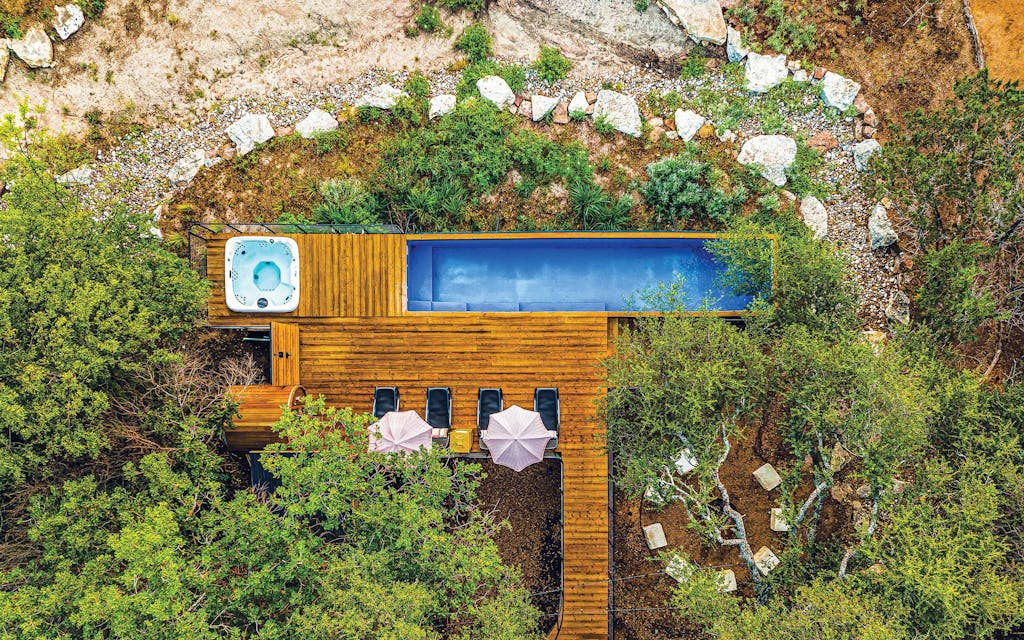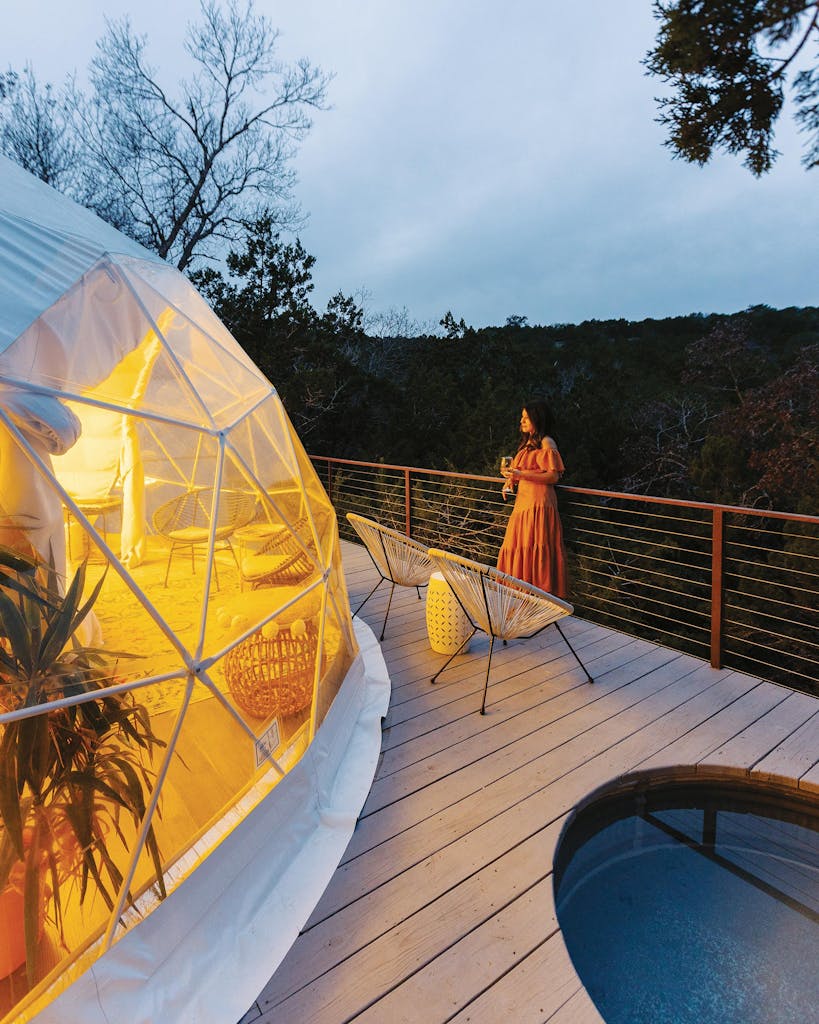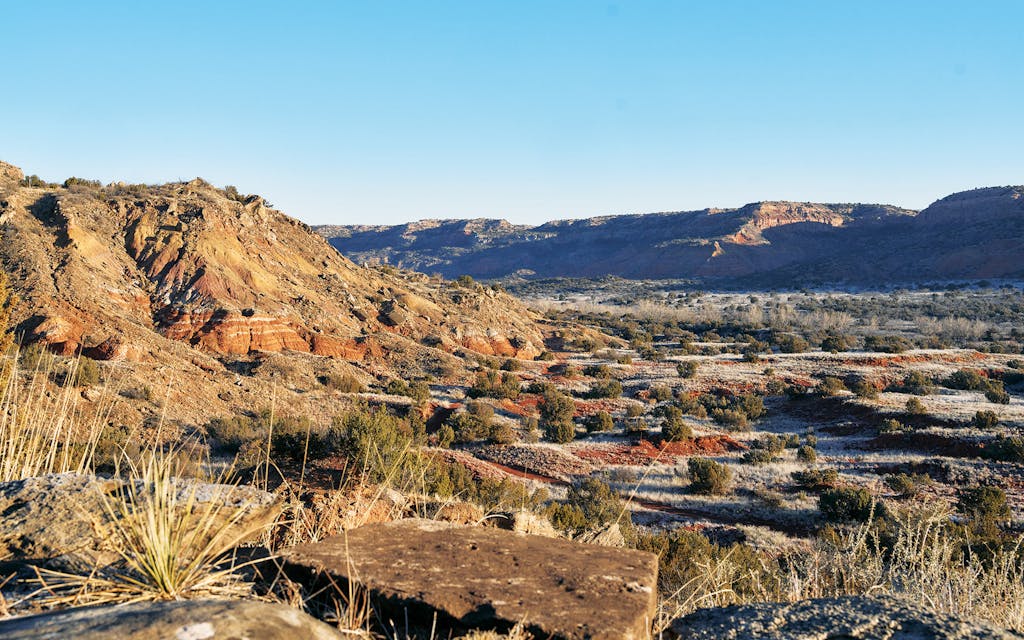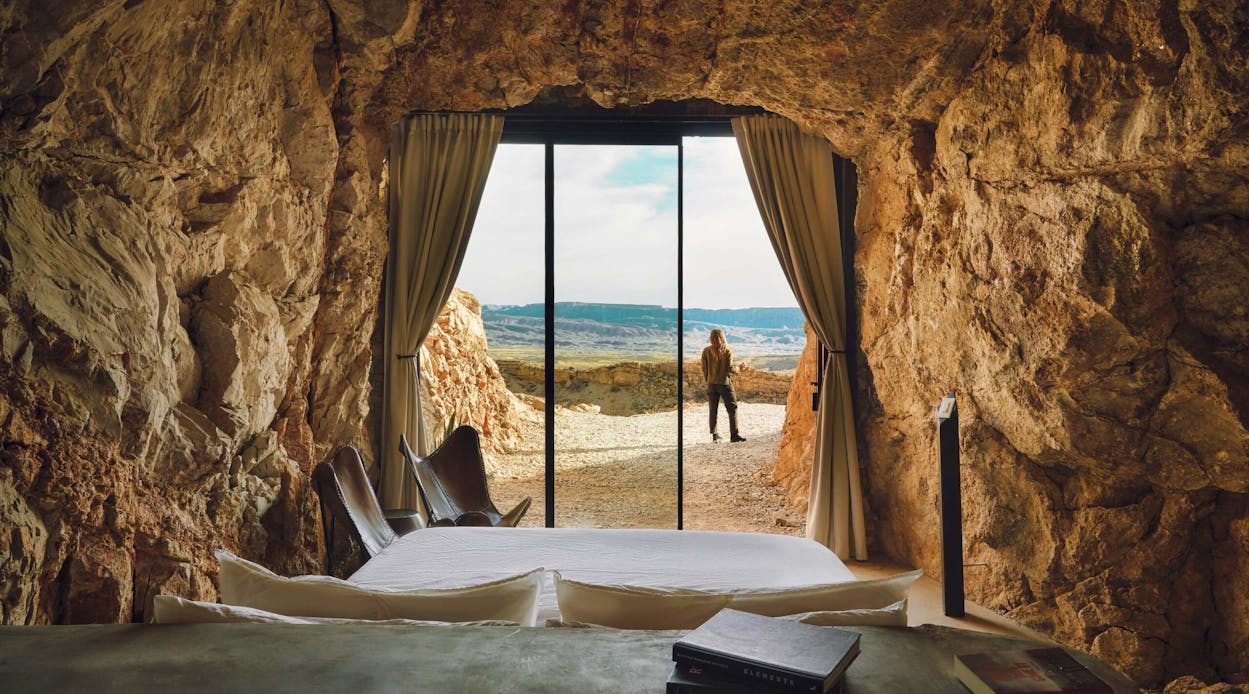The glass door to Crystal Cave, a site at the Summit at Big Bend resort, reminded me of the wardrobe that leads to Narnia. But this portal was hidden in the jagged cliffsides of the high desert. As I pulled it open, I felt like I was straddling two worlds: Outside, an electric blue West Texas sky throbbed over the brown mountains stretching to Mexico. Inside, an intimate haven beckoned with a king-size white bed, mini fridge, and Instagram-ready two-person shower.
“We’re getting married tonight,” I told my friend, which was awkward because she has a husband, but I was struck by an overwhelming desire to have my honeymoon here. Our room was one of two luxury suites constructed into the side of Tres Cuevas Mountain, once a mining site for cinnabar, an ore containing mercury. I could see, out on the horizon, the resort’s white geodesic domes dotting the dusty, barren landscape. But this cave was like nothing I’d ever experienced—a curious mix of upscale and prehistoric. Veins of purple and pink crystal ran along the craggy interior walls, but the space was climate-controlled and stocked with thoughtful touches. Even the liquid hand soap next to the copper vessel sink smelled perfect.
“Glamping” is a term of comic elasticity. An oversized air mattress in a fancy tent can technically be called glamping, but so can a stunning lakeside A-frame with a spiral staircase. The popularity of the word, a portmanteau of “glamour” and “camping,” can be traced back to an article in the Guardian, in 2005, though luxury camping stretches back to Ottoman tents in the
Middle Ages. The Oxford English Dictionary added “glamping” in 2016, the same year as “tl;dr”—both have a sped-up metabolism, conveying more with less.
I considered glamping a fake trend in the beginning, one of those activities that exist primarily so that travel writers can spin a good headline. The joke was on me. Glamping has exploded over the past decade, with yurts, renovated Airstreams, and geodesic domes popping up across the state and the country. The term became a buzzword on Airbnb, where regular houses started boasting of soaking tubs and firepits and hammocks swinging in a gentle breeze. During the pandemic, when construction shut down in other states at the very moment everyone wanted to flee their homes, business-friendly Texas became something of a glamping hot spot. Clever entrepreneurs made the most of a travel landscape shifting before our eyes.

The Summit at Big Bend was founded by Brent Pickette and Ian Vollers, outdoors enthusiasts who met working in Houston’s energy industry. In 2021 they purchased more than a thousand acres of private land near Big Bend National Park, between Terlingua and Lajitas on Farm-to-Market Road 170. Six months later they had the Summit up and running, and they have refined and expanded it since. A cafe and refreshment center will open by early next year.
My friend was dubious when I invited her to stay in a luxury cave. Would we be spelunking? How many scorpions would sting us? She’s a lawyer, a skeptic by trade, but as we explored the cave’s dazzling interior, posing for pictures like travel influencers, she had to admit that this place felt special. I built a campfire in the pit on the cliff’s edge while she snuggled under the duvet, tapping on her phone (the Wi-Fi worked fine). As a full moon rose in the clear, bright sky, I felt as though I’d discovered the edge of the universe—and it came with a Nespresso machine.


Like so much in our culture these days, glamping owes a lot of its popularity to social media. Instagram practically exists for photos of once-in-a-lifetime adventures. Search for hashtags such as #bucketlist, #YOLO, and #vanlife and you’ll find images of chic tiny homes under fir trees, or a beat-up van turned into a disco on wheels. The push to travel better and more uniquely has elevated the no-frills business of camping to a sumptuous feast of high-end sheets, fluffy white robes, and in-room massages. Meanwhile, the pressure to reach beyond cliché—toes dipped in the infinity pool, hot chocolate on the balcony at sunset—has inspired many a #glamping selfie. Hot chocolate in a cave at sunset? Now that’s a new one.
And glamping solves one of the toughest conundrums of actual camping: mostly that it’s hard. The ground is hard, pitching a tent is hard (particularly in wind), and peeing on the ground, while not hard, evokes hard living in a way that many travelers—particularly if they’re female, particularly if they have a nice pedicure—might prefer to avoid.
Stats on glamping are tricky to pin down because its name gets deployed as carelessly as “luxury” or “peaceful,” but a 2022 study by a travel-consulting website listed Austin as the number three glamping city in the country, behind number one Asheville, North Carolina, and (didn’t see this coming) Las Vegas. The city that keeps it weird definitely has its share of off-kilter lodging. I once stayed in a renovated school bus on the East Side, partly because it cost only around $100 a night and partly because it sounded cool. But search Airbnb for tree houses in Austin and you’ll be directed to Dripping Springs, Spicewood, Wimberley. That’s because the real heart of Texas glamping is not the Capital City but the Hill Country, where copses of juniper and red oak turn any scrap of land into an enchanted forest.
For my first glamping stop, I chose Onera, in Fredericksburg, a town eighty miles west of Austin that I knew mostly for its wineries. “Onera” comes from the Greek word for “dreams,” and its website had a calm, otherworldly vibe. “Reconnect to Nature. Awaken Your Soul,” read the home page, atop photos of a white bed nestled inside the fluted wooden tunnel of a horizontal, tubular tree house—an eye-catching structure known as the Spyglass because the circular glass entrance peers onto the property. I imagined it would be like sleeping in a giant telescope.

I booked a different stunner on the property, the Monarch, “named after the regal butterfly,” the website intoned in a lofty British accent—at least it did in my head as I read it. But the closer I looked, the more I could see it: the dual rhomboid of the building definitely resembled wings. What sold me, however, was how it was elevated ten feet off the ground, in a mature elm.
Tree houses evoke that fairytale quality of nostalgia and derring-do. For me, they summon not only childhood (“No boys allowed!”) but also literature’s great heroes, like a Swiss family named Robinson. This combination of familiarity and escape must be what makes these structures such a popular glamping choice. Cypress Valley, in the Hill Country hamlet of Spicewood, and Savannah’s Meadow, in the northeast Texas town of Celeste, advertised dainty wooden bedrooms as intricate as jewel boxes, and staircases that wound around a tall trunk, but they were booked or closed for the winter. (Some glamping sites are open only seasonally.)
A relative newcomer on the scene, Onera was cofounded and developed by New Yorker turned Austinite Ben Wolff. “I was a glamping daydreamer with no real plan,” he wrote recently on social media, in one of those posts that act as both promotion and DIY inspiration. If I can do it, you can do it. Back in 2019, Wolff and his wife took a fifty-day RV honeymoon through the national parks and fell in love with the mesas and mountains, sipping coffee as they stared into open vistas—but the RV was a constant struggle. One day the latch broke on the outdoor storage compartment, and their things started flying out as they tore down the highway.


“We wanted Onera to be a frictionless experience,” Wolff told me. He was calling from Wimberley, where he’s building a second Onera location, scheduled to open this summer. “All the comforts of home and then some.”
I imagined a vast countryside studded with eye-popping architecture, but Onera sits on six acres less than two miles from the Fredericksburg town square, earning it points for convenience at least. Charming structures that seemed remote and expansive in the website photos were actually plotted close together. I drove along the gravel road past an African-style safari hut, a shipping-container home, and a geodesic dome—a glamping sampler platter.

The Monarch, tucked behind a thatch of juniper, was equal parts stunning and homey. Constructed by Artistree Home, the Spicewood-based architects behind Cypress Valley, it looked like the kind of marvel you might see in a modern museum rather than a short drive from an Ace Hardware. I lugged my bag up a curved staircase to a wooden deck strung with Edison bulbs, and I slid open the glass door to a welcoming living area with a tan leather couch and a bistro table. A separate bedroom featured oversized floor-to-ceiling windows that looked on to sycamores and mulberry and pepper vine leading out to a creek, but is it petty of me to point out this was not an actual tree house? Ten feet off the ground, yes, and a cedar elm helped support the patio and staircase. But to be precise: this was a house next to a tree.
“There are a lot of reasons we don’t want the tree to be the support of the house,” Wolff told me later. “It’s for the safety of the tree and the long-term safety of the structure. In the wrong storm, and we’ve had a lot of those lately, a tree could become structurally unsound.”
Monarch gave off a sense of tree house whimsy, though, with playful touches including a metal ladder that takes you from the living area to a loft space, where a mattress makes for a second sleeping spot. Some features looked cool but felt strange, such as the big black cargo hammock slung across the open air of a vaulted ceiling underneath a skylight. Fun! But its thick ropes dug into my sides, and they creaked ominously when I lay down, making my quirky endeavor seem very dicey. I had traveled alone to Onera. If this thing collapsed, who would find me? Would I die here, within eyeshot of the air fryer and before I’d even tried the outdoor stone tub?
Safety is one of the open questions of glamping. Getting away from it all comes with risk as well as pleasure. Those peaceful rural landscapes of Texas hide howling night prowlers and creatures that slither. Most glamping operates like a typical Airbnb, with instructions emailed or texted, a digital keypad lock, and no on-site concierge; sometimes there’s no one in the vicinity at all. (Onera does offer around-the-clock email support and a staff member living on-site.) Such isolation can feel glorious—until it feels scary. In this way, glamping greatly resembles camping, an endeavor of self-reliance and pluck. But because your typical glamper is a city slicker like me, so detached from nature that the sight of a snake could induce a panic attack, there is much to be said for an experience that looks remote yet isn’t.

The name is what drew me to my second destination in the Hill County: Missing Hotel, in Marble Falls. I found the word comforting—go missing; find what you’re missing. Then again, “missing” in giant letters can summon milk cartons and true crime documentaries, making it not the most enticing word for your solo female traveler. Anyway, I brought a friend.
Everything I’d hoped for in a Hill Country getaway I found at Missing, a sprawling delight of pasture and rolling hills fifteen miles from the nearest H-E-B. I’d booked the Ukiyo geodesic dome (ukiyo is Japanese for “living in the moment”), whose interior design was inspired by Wes Anderson’s Moonrise Kingdom. I assumed that was a gimmick until I saw clever touches such as a mini canteen on a bookshelf and arrows over the bed that doubled as hangers. (The pointy ends emerged out the other side, in the bathroom.)
Geodesic domes were invented during World War I and popularized in the sixties and seventies by futurist Buckminster Fuller, in some ways the Elon Musk of his day. The concept of a polyhedron structure, like a clear soccer ball cut in half, appealed for its sturdiness and voluminous interior, but in the century since its arrival the geodesic dome has more or less remained a curiosity. Furniture is hard to place without walls, it turns out, and the high dome leaves all this empty space at the top. But over the past few years, geodesic domes have become a popular choice at glampsites. They are easy builds (you can purchase one on Amazon) with a groovy, futuristic look that makes a traveler feel like they’re living in a Stanley Kubrick movie.


The property belongs to Sam and Stephen Hopkins, a globe-trotting couple inspired by travel in Japan and minimal design. A metal ladder led to a queen-size loft bed. The shower had a curved door, like a space capsule’s. An amoeba-shaped mirror and a tall bookcase were backlit by LEDs that gave the dome a warm glow. A fluffy black-and-white cat wandered to our door (we’d been warned in the instructions), and we let her stay the night, curling up between us on the downstairs bed as we watched Love Is Blind, which my friend had downloaded prior to our trip.
Exploring the one-hundred-acre property felt like being on a scavenger hunt, with Easter eggs in random places: a swing hanging from a century-old oak; a high cliff with a small driving range, where golfers can send balls sailing into the great beyond (the balls land near a creek and are collected later); a meditation labyrinth; a cornhole setup near the entry; and two Scottish Highland cattle named Elvis and Presley.
Tom Hopkins, Stephen’s father, runs the property with his friendly goldendoodle, Piper, and he lives in an Airstream a short walk from the sites. In all my glamping adventures, he was the only overseer I met in person. Amiable and just the right amount of chatty, Hopkins gave us a bouncy tour in his Kawasaki Mule utility terrain vehicle, pointing out secret hammocks and one spot where a couple got engaged. A retired consultant, Hopkins moved to Texas from Denver during the pandemic. “This was my kids’ dream,” he said. His daughter Courtney does the creative branding. Missing offers eleven units, including a gorgeous villa called the Zephyr, whose deck boasts comfy hanging chairs and an outdoor shower.
Our dome faced a panoramic green countryside. The neighboring site sat a short walk from ours, but it felt like we had Mother Nature all to ourselves. I roasted hot dogs over a firepit while my friend grilled corn and portobellos on the gas grill. We soaked in our private hot tub as the moon sneaked over the treetops. Our site lay at the mouth of a path to the Mystical Forest, which lived up to its name. We flopped down on a large mattress in a clearing of trees, several draped with fairy lights that created a perimeter of soft light, and stared up at the stars.
As we headed back to our real beds, we saw the pointy ears of our furry companion through the dome’s clear, hard plastic. It’s no small gift: to feel far away but also at home.

Glamping isn’t cheap, though. Rates blasted past $500 a night at many sites I considered—sticker shock for a woman who used to car camp for a $15 fee. Back in my twenties, I road-tripped across the country for five months, leapfrogging from one national park to the next, the orange-pink hoodoos of Bryce becoming the jagged incisors of Zion becoming the ancient redwoods of Northern California. Friends hated that I camped alone, but these parks felt safe to me, given that roadside serial killers rarely bother with entry fees, though I knew that bears and mountain lions were another story.
Car camping became a pleasant middle ground during my newbie traveling years, a way to dip a toe in the wilderness without being swallowed by it. I had neighbors in hollering distance and a trunk full of supplies and a flush toilet close by. To some outdoors enthusiasts, this didn’t count
as camping at all. In his 1968 environmental classic, Desert Solitaire: A Season in the Wilderness, the delightfully dyspeptic writer Edward Abbey bemoans the highways paved across national parks, which introduced traffic and cheap souvenirs and car-spoiled dilettantes to the untouched splendor. “A man on foot, on horseback or on a bicycle will see more, feel more, enjoy more in one mile than the motorized tourists can in a hundred miles,” he writes. Could be, but without asphalt, I likely never would have fallen in love with national parks (and neither would millions of other Americans). The splendor might remain untouched, but for whom?
Glamping, then, is the next installment in our ongoing compromise between nature and modernity, between roughing it and being pampered. Hard-core types might scoff at the high-end appliances and luxury amenities, but if you could revel in the glory of the outdoors and get a nice meal and a good night’s sleep, why wouldn’t you?

So far I’d traveled only to private properties, but my next adventure took me inside a state park. Just 5 percent of Texas is public land, a puny number for a state that likes to brag that everything is bigger. But even 5 percent of a place as vast and varied as Texas leaves a lot of panoramas for the urbanite to explore.
I felt awestruck after I entered Palo Duro Canyon State Park and headed toward Palo Duro Glamping, built (you guessed it) during the pandemic. This park is one of Texas’s best-kept secrets despite being home to America’s second-largest canyon, after the Grand one. It’s a prehistoric layer cake of shale and siltstone and sandstone thirty miles southeast of Amarillo. Dusty Harris, who owns the park’s Trading Post store (don’t miss the burgers), began the build in 2020, sketching the plans one day on a slip of paper.
Four sites line a gravel pathway with a spectacular view of the reddish-brown canyon. When it comes to design, Mother Nature beats a Pinterest board. The comfortably rustic accommodations—wood structures covered in white canvas for a tentlike feel—feature AC and heat as well as a full-sized fridge, but there’s no sink or toilet. (A public bathhouse stood a short walk away.) A white plastic bucket sat in the corner of my unit for “emergencies,” but it cost $8 to use, and I’m a cheapskate, so let’s just say the ground to the right of my tent became familiar.


Palo Duro was more family friendly than the other resorts, which seemed more fine-tuned for couples enacting their own version of The Bachelor’s date night. It’s also more affordable, at $299 a night. Family games lined the shelves, while the light-strung patio offered rocking chairs, a gas grill, and a firepit. Other visitors’ kids scampered on the pathway, but lazing in my hammock, I couldn’t even hear them. The canyon ate the sound.
My room was spacious enough for two queen-size beds as well as a picnic table and a futon. A family could fit comfortably, but as a woman alone, I didn’t feel overwhelmed. I carried my complimentary s’mores kit outside to the propane firepit. “I am not enough of a suburban father to figure this out,” I thought as I flicked and fiddled helplessly, but after fifteen minutes, kaBOOM. We had flame.
The sounds and sights of nature are, for my money, better than streaming television. The squawk of a wren, the silvery rustle of wind through the cottonwood trees, a waxing gibbous moon. Eventually, though, I retired to my bed and watched Netflix on my phone. Look, I’m only human.
The next morning I set out on the Kiowa Trailhead, a short walk from my patio (Glampsite C, though I’d book D if I had to do it all over again). The 2.9-mile round-trip trail was an easy ramble across riverbeds and along a deep orange-red cliffside with white strips of gypsum that looked like a red velvet cake with thin layers of buttercream icing. The hike was robust enough that I was sweating by the time I reached my hammock but seemed easy enough for the children and families with leashed dogs that I passed.
As I read barefoot in the hammock, my glossy red toes stood in curious relief to the ancient canyon. Most Texans are trapped in the city these days, even if our boots and trucks suggest otherwise, and however on-trend “glamping” might sound, it’s also an old-fashioned return to a time when we knew the land—how the sky tells time, how a tree signals a particular microclimate. Glamping is a chance to be freed from noise and the streetlamps that blot out the stars.

Nowhere on my glamping tour offered a better reminder than my final stop: the Summit at Big Bend. A luxury cave in a Mars-like landscape: it’s hard to top. For dinner during our stay, my friend and I roasted our hot dogs (tofu for her) and toasted our marshmallows as the North Star began to pulse. The sky of far West Texas makes up for all the nonsense we tolerate to live in this state: the clown cars of politicians, the urban sprawl. When I think, as I do often, Wait, why DO I live in Texas?, I stare up at that dome, the ghostly spine of the Milky Way, and I think: Oh, right.
“I really planned to make fun of this place,” my lawyer friend told me. “Like, how could a hotel in a cave be like camping?” But as we curled up under the covers that night, she pointed to the crystals dotting the stone walls. When I turned off the lamp, those crystals shimmered in the pitch-black night like a constellation.
This article originally appeared in the April 2024 issue of Texas Monthly with the headline “Glamp Across Texas.” Subscribe today.
- More About:
- Longreads
- Marble Falls
- Fredericksburg
- Big Bend







